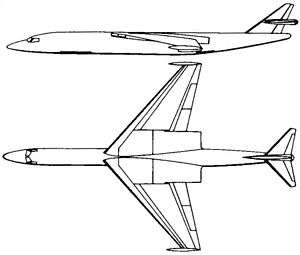Boeing XB-59
| XB-59 | |
|---|---|
 | |
| Boeing concept drawing of the XB-59 | |
| Role | Supersonic medium bomber |
| National origin | United States |
| Manufacturer | Boeing |
| Status | Cancelled |
| Primary user | U.S. Air Force |
| Number built | 0 |
|
| |
The XB-59, Boeing model number 701, was a 1950s proposal for a United States supersonic bomber aircraft.
Design and development
In 1949 the US government canceled the Boeing XB-55 contract, which had been an effort to produce a subsonic replacement for the just-being-introduced Boeing B-47 Stratojet. The XB-55 project had started in 1947, but by the end of the decade it was apparent that if strategic penetration in warfare were to be successful at all, it would require aircraft much faster than the jet fighter aircraft which were then being placed into operation. Thus the funding made available by the XB-55 cancellation was earmarked for the study of a supersonic medium bomber, and a request for proposals was extended to several aircraft companies.
Boeing submitted a proposal for a four-engine, high-wing aircraft with a highly streamlined fuselage. The four engines would be buried in thickened wing roots; the remaining wing planform was highly tapered.
Developed under weapons system designation MX-1965, the XB-59 was to have a crew of three, and would be powered by four GE J73-X24A turbojet engines, mounted in the roots of the 73 foot span wings. The landing gear would be similar to the bicycle arrangement found on the B-47 and B-52 Stratofortress, with wingtip-mounted outriggers.
The Boeing contract for the XB-59 was canceled in late 1952 after the Convair company's submission, designated B-58 Hustler, was selected for development.
The Boeing effort was a design study only, and no construction was involved.
Specifications
Data from "US Bombers," Lloyd S. Jones, 1974
General characteristics
- Crew: 3
- Length: 123 ft 4 in (37.59 m)
- Wingspan: 81 ft 4 in (24.79 m)
- Height: 25 ft 5 in (7.75 m)
- Wing area: 1,650 sq ft (153 m2)
- Empty weight: 63,200 lb (28,667 kg)
- Gross weight: 148,300 lb (67,268 kg)
- Powerplant: 4 × General Electric J73-X24A afterburning turbojets, 14,000 lbf (62 kN) with afterburner
Performance
- Maximum speed: Mach 2
- Range: 2,380 mi (2,068 nmi; 3,830 km)
- Service ceiling: 51,000 ft (15,545 m)
Armament
- Guns: 1 30mm cannon in tail
See also
- Aircraft of comparable role, configuration and era
- Related lists
External links
| Wikimedia Commons has media related to Boeing XB-59. |